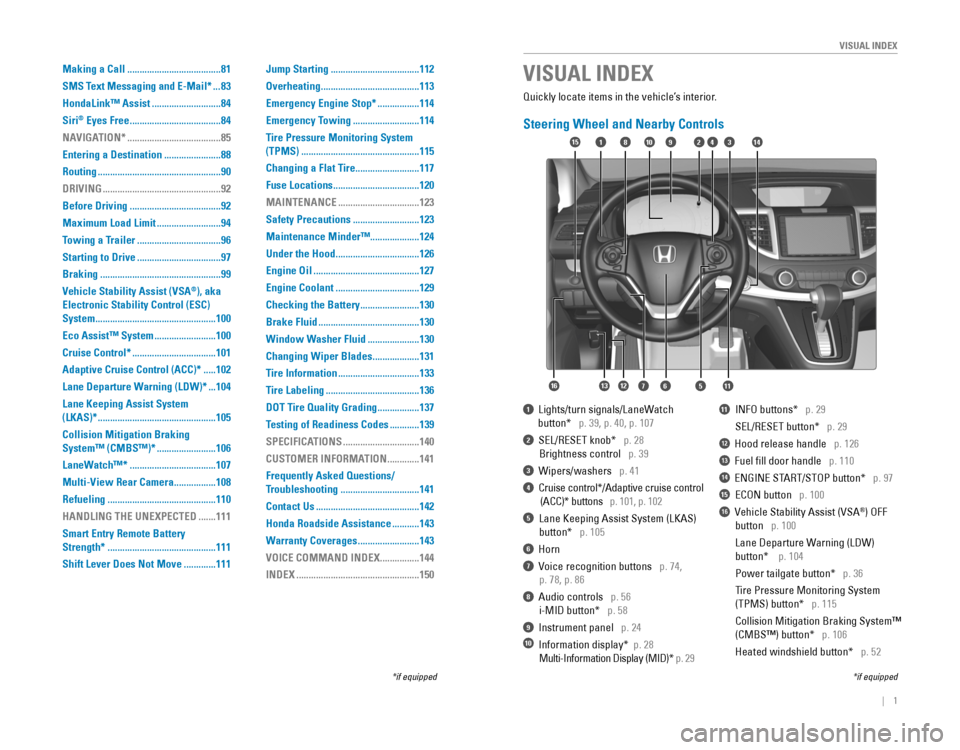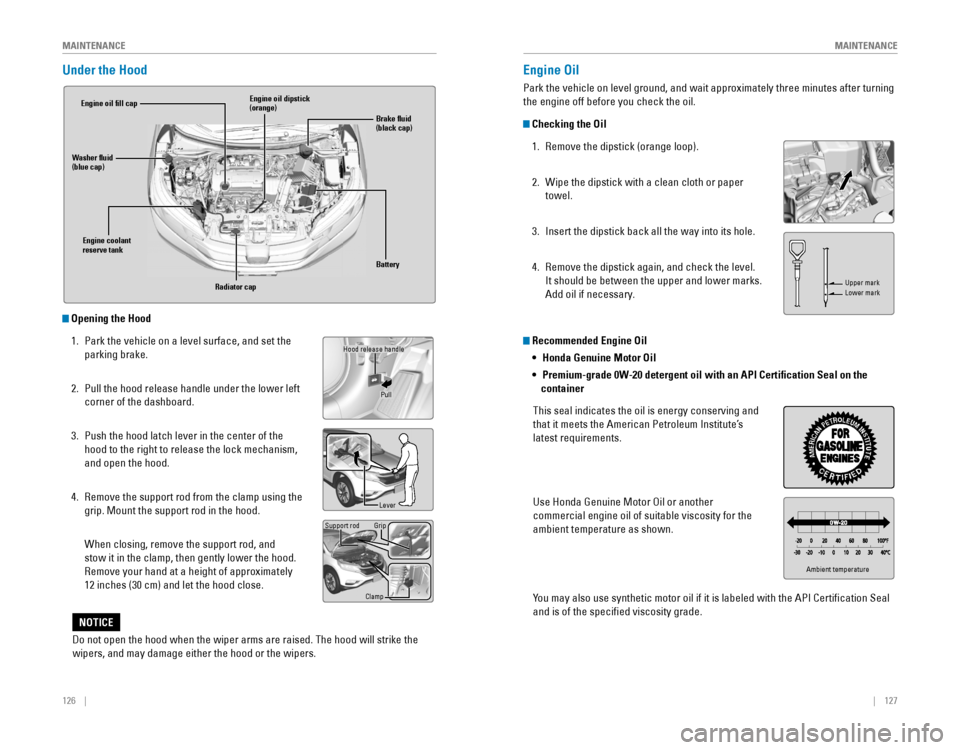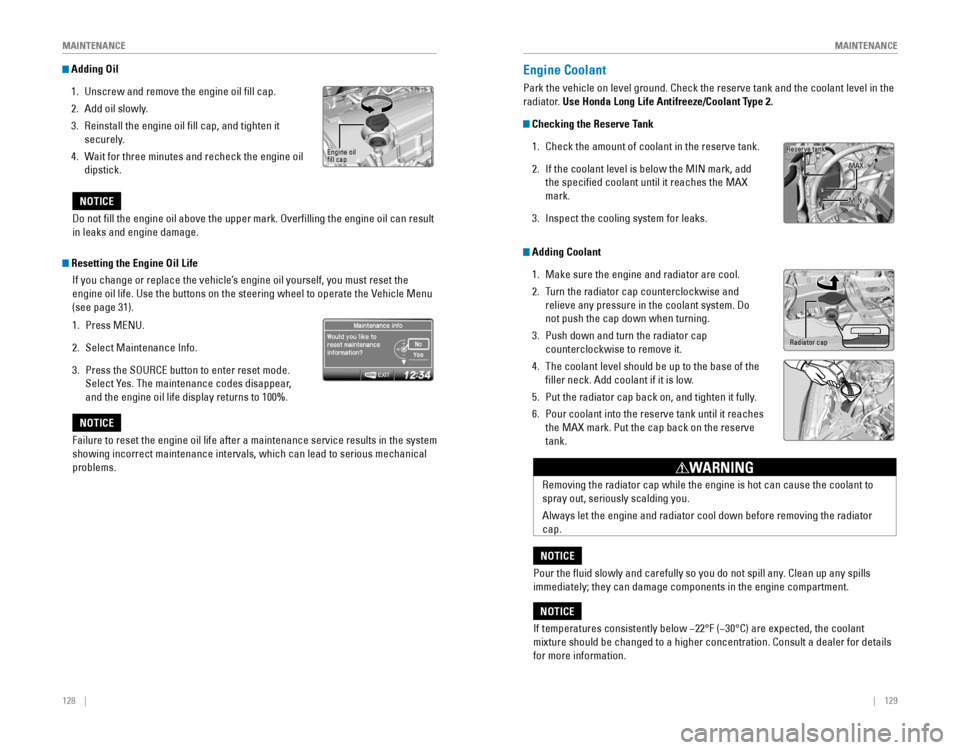checking oil HONDA CR-V 2016 RM1, RM3, RM4 / 4.G Quick Guide
[x] Cancel search | Manufacturer: HONDA, Model Year: 2016, Model line: CR-V, Model: HONDA CR-V 2016 RM1, RM3, RM4 / 4.GPages: 80, PDF Size: 7.99 MB
Page 4 of 80

| 1
VISUAL INDEX
Quickly locate items in the vehicle’s interior.
Steering Wheel and Nearby Controls
1‚ÄÇ‚ÄÇLights/turn‚ÄÇsignals/LaneWatch
‚ÄÇ‚ÄÇ‚ÄÇ‚ÄÇ‚ÄÇ‚ÄÇbutton*‚ÄÇ‚ÄÇ‚ÄÇp.‚ÄÇ39,‚ÄÇp.‚ÄÇ40,‚ÄÇp.‚ÄÇ107
2‚ÄÇ‚ÄÇSEL/RESET‚ÄÇknob*‚ÄÇ‚ÄÇ‚ÄÇp. 28
Brightness control p. 39
3‚ÄÇ‚ÄÇWipers/washers‚ÄÇ‚ÄÇ‚ÄÇp.‚ÄÇ41
4‚ÄÇ‚ÄÇCruise‚ÄÇcontrol*/Adaptive‚ÄÇcruise‚ÄÇcontrol‚ÄÇ‚ÄÇ
‚ÄÇ(ACC)*‚ÄÇbuttons‚ÄÇ‚ÄÇ‚ÄÇp. 101, p. 102
5 Lane Keeping Assist System (LKAS)
‚ÄÇbutton* p. 105
6 Horn
7‚ÄÇ‚ÄÇVoice‚ÄÇrecognition‚ÄÇbuttons‚ÄÇ‚ÄÇ‚ÄÇp.‚ÄÇ74,
‚ÄÇp.‚ÄÇ78,‚ÄÇp.‚ÄÇ86
8 Audio controls p. 56
i-MID‚ÄÇbutton*‚ÄÇ‚ÄÇ‚ÄÇp. 58
9‚ÄÇ‚ÄÇInstrument‚ÄÇpanel‚ÄÇ‚ÄÇ‚ÄÇp.‚ÄÇ24
10‚ÄÇ‚ÄÇInformation‚ÄÇdisplay*‚ÄÇ‚ÄÇp. 28
‚ÄÇMulti-Information‚ÄÇDisplay‚ÄÇ(MID)*‚ÄÇp. 29
11‚ÄÇ‚ÄÇ‚ÄÇINFO‚ÄÇbuttons*‚ÄÇ‚ÄÇ‚ÄÇp. 29
SEL/RESET‚ÄÇbutton*‚ÄÇ‚ÄÇ‚ÄÇp. 29
12 Hood release handle p. 126
13 Fuel fill door handle p. 110
14‚ÄÇ‚ÄÇENGINE‚ÄÇSTART/STOP‚ÄÇbutton*‚ÄÇ‚ÄÇ‚ÄÇp.‚ÄÇ97
15 ECON‚ÄÇbutton p. 100
16  Vehicle Stability Assist (VSA®) OFF
‚ÄÇbutton‚ÄÇ‚ÄÇ‚ÄÇp. 100
‚ÄÇLane‚ÄÇDeparture‚ÄÇWarning‚ÄÇ(LDW)‚ÄÇ‚ÄÇ ‚ÄÇ
‚ÄÇbutton*‚ÄÇ‚ÄÇ‚ÄÇ‚ÄÇp.‚ÄÇ104
‚ÄÇPower‚ÄÇtailgate‚ÄÇbutton*‚ÄÇ‚ÄÇ‚ÄÇp. 36
Tire Pressure Monitoring System
‚ÄÇ(TPMS)‚ÄÇbutton*‚ÄÇ‚ÄÇ‚ÄÇp. 115
Collision Mitigation Braking System‚Ñ¢
‚ÄÇ(CMBS‚Ñ¢)‚ÄÇbutton*‚ÄÇ‚ÄÇ‚ÄÇp. 106
‚ÄÇHeated‚ÄÇwindshield‚ÄÇbutton*‚ÄÇ‚ÄÇ‚ÄÇp. 52
VISUAL INDEX
*if‚ÄÇequipped*if‚ÄÇequipped
92
567111213
1815341014
16
Making a Call ......................................81
SMS Text Messaging and E-Mail*
...83
HondaLink‚Ñ¢ Assist
............................84
Siri
® Eyes Free .....................................84
NAVIGATION*
......................................85
Entering a Destination
.......................88
Routing
..................................................90
DRIVING
................................................92
Before Driving
.....................................92
Maximum Load Limit
..........................94
Towing a Trailer
..................................96
Starting to Drive
..................................97
Braking
.................................................99
Vehicle Stability Assist (VSA
®), aka
Electronic Stability Control (ESC)
System
.................................................100
Eco Assist‚Ñ¢ System
.........................100
Cruise Control*
..................................101
Adaptive Cruise Control (ACC)*
.....102
Lane Departure Warning (LDW)*
...104
Lane Keeping Assist System
(LKAS)*
................................................105
Collision Mitigation Braking
System‚Ñ¢ (CMBS‚Ñ¢)*
........................106
LaneWatch‚Ñ¢*
...................................107
Multi-View Rear Camera
.................108
Refueling
............................................110
HANDLING THE UNEXPECTED
.......111
Smart Entry Remote Battery
Strength*
............................................111
Shift Lever Does Not Move
.............111 Jump Starting
....................................112
Overheating
........................................113
Emergency Engine Stop*
.................114
Emergency Towing
...........................114
Tire Pressure Monitoring System
(TPMS)
................................................115
Changing a Flat Tire
..........................117
Fuse Locations
...................................120
MAINTENANCE
.................................123
Safety Precautions
...........................123
Maintenance Minder‚Ñ¢ ....................124
Under the Hood
..................................126
Engine Oil
...........................................127
Engine Coolant
..................................129
Checking the Battery
........................130
Brake Fluid
.........................................130
Window Washer Fluid
.....................130
Changing Wiper Blades
...................131
Tire Information
.................................133
Tire Labeling
......................................136
DOT Tire Quality Grading
.................137
Testing of Readiness Codes
............139
SPECIFICATIONS
...............................140
CUSTOMER INFORMATION
.............141
Frequently Asked Questions/
Troubleshooting
................................141
Contact Us
..........................................142
Honda Roadside Assistance
...........143
Warranty Coverages
.........................143
VOICE COMMAND INDEX
................144
INDEX
..................................................150
Page 67 of 80

126 ||‚ÄÇ‚ÄÇ‚ÄÇ‚ÄÇ127
MAINTENANCE
MAINTENANCE
Under the Hood
Opening the Hood
1. Park the vehicle on a level surface, and set the
parking‚ÄÇbrake.
2. Pull the hood release handle under the lower left
corner‚ÄÇof‚ÄÇthe‚ÄÇdashboard.
3. Push the hood latch lever in the center of the
hood to the right to release the lock mechanism,
and open the hood.
4.‚ÄÇRemove the support rod from the clamp using the
grip. Mount the support rod in the hood.
When closing, remove the support rod, and
stow it in the clamp, then gently lower the hood.
Remove your hand at a height of approximately
12 inches (30 cm) and let the hood close.
Engine coolant
reserve tank
Washer fluid
(blue cap)
Engine oil fill cap
Engine oil dipstick
(orange)
Brake fluid
(black cap)
Battery
Radiator cap
Hood release handle
Lever
Support rod Grip
ClampPull
Do‚ÄÇnot‚ÄÇopen‚ÄÇthe‚ÄÇhood‚ÄÇwhen‚ÄÇthe‚ÄÇwiper‚ÄÇarms‚ÄÇare‚ÄÇraised.‚ÄÇThe‚ÄÇhood‚ÄÇwill‚ÄÇstrike‚ÄÇthe‚ÄÇ
wipers, and may damage either the hood or the wipers.
NOTICE
Recommended Engine Oil
• 
Honda Genuine Motor Oil
•  Premium-grade 0W-20 detergent oil with an API Certification Seal on the
container
This seal indicates the oil is energy conserving and
that it meets the American Petroleum Institute’s 
latest‚ÄÇrequirements.
Use Honda Genuine Motor Oil or another
commercial‚ÄÇengine‚ÄÇoil‚ÄÇof‚ÄÇsuitable‚ÄÇviscosity‚ÄÇfor‚ÄÇthe‚ÄÇ
ambient‚ÄÇtemperature‚ÄÇas‚ÄÇshown.
You‚ÄÇmay‚ÄÇalso‚ÄÇuse‚ÄÇsynthetic‚ÄÇmotor‚ÄÇoil‚ÄÇif‚ÄÇit‚ÄÇis‚ÄÇlabeled‚ÄÇwith‚ÄÇthe‚ÄÇAPI‚ÄÇCertification‚ÄÇSeal‚ÄÇ
and is of the specified viscosity grade.
Engine Oil
Park the vehicle on level ground, and wait approximately three minutes after turning
the‚ÄÇengine‚ÄÇoff‚ÄÇbefore‚ÄÇyou‚ÄÇcheck‚ÄÇthe‚ÄÇoil.
Checking the Oil
1. Remove the dipstick (orange loop).
2. Wipe the dipstick with a clean cloth or paper
towel.
3. Insert‚ÄÇthe‚ÄÇdipstick‚ÄÇback‚ÄÇall‚ÄÇthe‚ÄÇway‚ÄÇinto‚ÄÇits‚ÄÇhole.
4.‚ÄÇRemove the dipstick again, and check the level.
It‚ÄÇshould‚ÄÇbe‚ÄÇbetween‚ÄÇthe‚ÄÇupper‚ÄÇand‚ÄÇlower‚ÄÇmarks.‚ÄÇ
Add oil if necessary.
Ambient‚ÄÇtemperature
Upper mark
Lower mark
Page 68 of 80

128 || 129
MAINTENANCE
MAINTENANCE
Adding Oil
1. Unscrew and remove the engine oil fill cap.
2. Add oil slowly.
3. Reinstall the engine oil fill cap, and tighten it
securely.
4.‚ÄÇWait for three minutes and recheck the engine oil
dipstick.Engine‚ÄÇoil‚ÄÇfill cap
Do‚ÄÇnot‚ÄÇfill‚ÄÇthe‚ÄÇengine‚ÄÇoil‚ÄÇabove‚ÄÇthe‚ÄÇupper‚ÄÇmark.‚ÄÇOverfilling‚ÄÇthe‚ÄÇengine‚ÄÇoil‚ÄÇcan‚ÄÇresult‚ÄÇ
in leaks and engine damage.
NOTICE
Failure to reset the engine oil life after a maintenance service results\
in the system
showing incorrect maintenance intervals, which can lead to serious mecha\
nical
problems.
NOTICE
Resetting the Engine Oil Life
If you change or replace the vehicle’s engine oil yourself, you must reset the 
engine‚ÄÇoil‚ÄÇlife.‚ÄÇUse‚ÄÇthe‚ÄÇbuttons‚ÄÇon‚ÄÇthe‚ÄÇsteering‚ÄÇwheel‚ÄÇto‚ÄÇoperate‚ÄÇthe‚ÄÇVehicle‚ÄÇMenu‚ÄÇ
(see page 31).
1. Press‚ÄÇMENU.
2. Select‚ÄÇMaintenance‚ÄÇInfo.
3. Press‚ÄÇthe‚ÄÇSOURCE‚ÄÇbutton‚ÄÇto‚ÄÇenter‚ÄÇreset‚ÄÇmode.
Select Yes. The maintenance codes disappear,
and‚ÄÇthe‚ÄÇengine‚ÄÇoil‚ÄÇlife‚ÄÇdisplay‚ÄÇreturns‚ÄÇto‚ÄÇ100%.
Engine Coolant
Park the vehicle on level ground. Check the reserve tank and the coolant\
level in the
radiator. Use Honda Long Life Antifreeze/Coolant Type 2.
Checking the Reserve Tank
1. Check the amount of coolant in the reserve tank.
2. If‚ÄÇthe‚ÄÇcoolant‚ÄÇlevel‚ÄÇis‚ÄÇbelow‚ÄÇthe‚ÄÇMIN‚ÄÇmark,‚ÄÇadd‚ÄÇ
the specified coolant until it reaches the MAX
mark.
3. Inspect‚ÄÇthe‚ÄÇcooling‚ÄÇsystem‚ÄÇfor‚ÄÇleaks.
If temperatures consistently below −22°F (−30°C) are expected, the coolant 
mixture‚ÄÇshould‚ÄÇbe‚ÄÇchanged‚ÄÇto‚ÄÇa‚ÄÇhigher‚ÄÇconcentration.‚ÄÇConsult‚ÄÇa‚ÄÇdealer‚ÄÇfor‚ÄÇdetails‚ÄÇ
for more information.
NOTICE
Reserve tank
MAX
MIN
Removing the radiator cap while the engine is hot can cause the coolant \
to
spray out, seriously scalding you.
Always‚ÄÇlet‚ÄÇthe‚ÄÇengine‚ÄÇand‚ÄÇradiator‚ÄÇcool‚ÄÇdown‚ÄÇbefore‚ÄÇremoving‚ÄÇthe‚ÄÇradiator‚ÄÇ
cap.
WARNING
Pour the fluid slowly and carefully so you do not spill any. Clean up any spills
immediately; they can damage components in the engine compartment.
NOTICE
Adding Coolant
1. Make sure the engine and radiator are cool.
2. Turn the radiator cap counterclockwise and
relieve‚ÄÇany‚ÄÇpressure‚ÄÇin‚ÄÇthe‚ÄÇcoolant‚ÄÇsystem.‚ÄÇDo‚ÄÇ
not push the cap down when turning.
3. Push down and turn the radiator cap
counterclockwise to remove it.
4.‚ÄÇThe‚ÄÇcoolant‚ÄÇlevel‚ÄÇshould‚ÄÇbe‚ÄÇup‚ÄÇto‚ÄÇthe‚ÄÇbase‚ÄÇof‚ÄÇthe‚ÄÇ
filler neck. Add coolant if it is low.
5. Put‚ÄÇthe‚ÄÇradiator‚ÄÇcap‚ÄÇback‚ÄÇon,‚ÄÇand‚ÄÇtighten‚ÄÇit‚ÄÇfully.
6. Pour coolant into the reserve tank until it reaches
the‚ÄÇMAX‚ÄÇmark.‚ÄÇPut‚ÄÇthe‚ÄÇcap‚ÄÇback‚ÄÇon‚ÄÇthe‚ÄÇreserve‚ÄÇ
tank.
Radiator cap